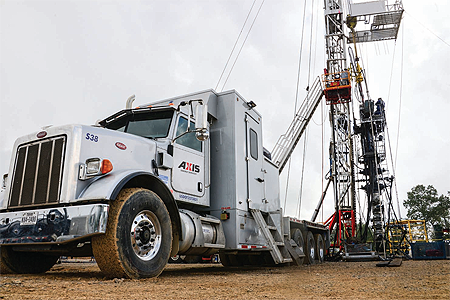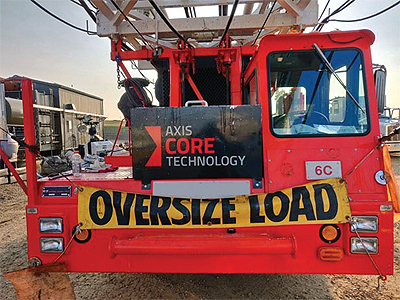Axis Energy Services: Pioneering Cost-Effective, Data-Driven Solutions for Shale Plays
A revolutionary way of working
The common challenge facing shale plays across the United States in 2020 is the need to drive down costs and cycle times, while at the same time continuously pushing the limits of extended-reach wells. Fortunately, help is at hand in the guise of Axis Energy Services (Axis), which is pioneering a new model of completion and workover services.
Formed in 2018, following the union of three highly regarded well service companies – TEC Well Service, Momentum Pressure Control, and M6 Energy Services – Axis today possesses offerings  including 24-hour drill outs, pressure control and pumping services, as well as pressure control equipment rentals. “Our integrated, data-driven and training focused approach delivers seamless solutions that drive efficiency and simplify operations,” begins Axis’ President and CEO, Dirk Lee. “Axis has made significant investments into technology, namely our high-spec equipment and real-time rig software, and predictive analytics on workover rigs, and into becoming a leader by implementing data and safety systems on snubbing units.
including 24-hour drill outs, pressure control and pumping services, as well as pressure control equipment rentals. “Our integrated, data-driven and training focused approach delivers seamless solutions that drive efficiency and simplify operations,” begins Axis’ President and CEO, Dirk Lee. “Axis has made significant investments into technology, namely our high-spec equipment and real-time rig software, and predictive analytics on workover rigs, and into becoming a leader by implementing data and safety systems on snubbing units.
“Additionally, Axis maintains a fleet of nitrogen pumping units to support a wide range of oilfield applications, brand new chemical mixing and injection units with built-in data acquisition to increase efficiencies during drill outs, and a new, diesel-powered torque and test service line.”
Focused services
Prior to 2018, TEC Well Service, Momentum Pressure Control, and M6 Energy Services each provided superior services focused around the well, and through Axis the three combined to create one completions-focused, data-driven company that utilises new, purpose-engineered equipment optimised for long laterals. “With a focus on completions and workovers across the board, we can offer our customers the convenience of providing the rig, high-horsepower pumps, support equipment, and all necessary pressure control equipment – all on one invoice – as part of our standard drill out service,” Dirk continues. “With our headquarters based in East Texas, and major operations in the Permian Basin, South Texas, Ohio and North Dakota, customers can trust Axis to be where they need us, and provide every service they need around the wellhead, without having multiple third parties at one rig location.”
As Dirk goes on to detail, 2019 will go down as being a very good year for Axis. “The oil and gas industry remains under pressure to reduce costs and improve efficiency as our customers struggle to live within their cash flow,” he says. “We think that Axis is uniquely positioned to support our customers through our data driven and analytics based services, which can lead to continuous improvements and reduce costs.
“During 2019, we also rolled out our proprietary Axis CORE® data acquisition system to about half of our fleet. CORE utilises a series of wireless sensors embedded in the rig and on key support equipment that allows us to capture all of the key data that we and our customers need to make better decisions. The equipment involves no additional rig up so it has zero impact on the time to rig up and move between wells. This data is available in real time to our customers on their computers, pads or phones.”
Some, but not all, of the data that collected when doing frac plug drill outs includes average time to drill out a plug, average time to next plug, name of the frac plug, depth in the well, weight on bit, rate of penetration, pump pressure, swivel torque, rig mobilisation time, third party downtime and all company downtime.
Problem solvers
By having a rich data source such as that provided by CORE, Axis has been able to learn several things that have significantly improved its own operations, while reducing its customer’s costs at  the same time. “For example, we know that drilling out a plug only takes a few minutes regardless of the brand of frac plug,” Dirk details. “A much bigger challenge is the residual sand in the well that causes major delays in getting to the next frac plug to drill out. The delay can be 10-to-20 times longer than actually drilling out the plug. However, the sand needs to be removed from the well in order for the well to produce at the expected rate. Our highspec drill out rigs and pumps are designed to efficiently remove this sand debris while we are drilling out the frac plugs.
the same time. “For example, we know that drilling out a plug only takes a few minutes regardless of the brand of frac plug,” Dirk details. “A much bigger challenge is the residual sand in the well that causes major delays in getting to the next frac plug to drill out. The delay can be 10-to-20 times longer than actually drilling out the plug. However, the sand needs to be removed from the well in order for the well to produce at the expected rate. Our highspec drill out rigs and pumps are designed to efficiently remove this sand debris while we are drilling out the frac plugs.
“We have also noticed that a lot of the delay in getting to the next plug is because the tool hand or well site consultant has a ‘rule of thumb’ that says, for example, to do a bottoms up pump sweep after every third plug drill out. A bottoms up pump sweep can take a minimum of 45 minutes to complete. With the data we have now from CORE, we can tell based on rate of penetration and pump pressure when the ‘optimal’ time for a pump sweep is rather than depending on a rule of thumb that may no longer be valid. We will begin working with our customers to see if we can safely reduce the number of pump sweeps during a drill out, which will save time and money.”
Another observation that Axis has made is that third party downtime is a much bigger problem than previously realised. “Third party vendors might include the BOP providers, wireline companies, downhole motor vendors, or flow back companies. In this sense our operations, and indeed every vendor on the pad, is held up until these third-party vendors fix their problems,” Dirk adds. “On a two-to-three day drill out job, third party downtime can amount to between 10 and 20 per cent of the total time spent on the job. Through CORE we capture all of this downtime including the vendor name and the reasons for the downtime. We can then provide our customers with an overview of the job and identify whether there is a chronic performance problem with third party vendors which is costing the customer money.
“One of our customers said that ‘CORE is like having a second well site supervisor on the location’, and we are learning more everyday as we collect and analyse the data we are collecting through it. We continue to roll out CORE technology to more of our rigs and support equipment and develop the post-job reports and KPI reports that are most useful to our field management and our customers. We also continue to expand our service offerings to capture more revenue at the well head.”
New options
Axis Energy Services has also recently added two new lines of service: Chemical Mixing and Torque and Test. “We have designed and built a data-driven chemical mixing and injection system for use with either stick pipe or coil tubing applications that can reduce the cost of chemicals and increase efficiencies during drill outs by accurately controlling the injection rate of chemicals pumped downhole and using the data acquisition to blend the chemicals more precisely,” Dirk proclaims. “We have also introduced a first-generation, comprehensive torque and test service to meet customer needs in all pressure testing applications. We’re focused on faster torque times and have developed a diesel-powered hydraulic booster system to accelerate torqueing and improve efficiencies, and are using a pressure testing pump powered by a pre-emissions diesel engine. Second-generation equipment will be introduced this year to include CORE technology, in order to record torque and test psi in real-time.”
Added value
Axis believes that the US oilfield services market in 2020 has changed, and that a lower level of activity and customers finding themselves under spending constraints is the new normal. As a result, the company thinks that customers will be looking to align with vendors that can provide more added value in their services, while at the same time reducing cost. “We think Axis is uniquely positioned to take advantage of this new market reality by exploiting our CORE data system, identifying areas of further cost reductions, and partnering with our customers to provide them with the data they need to ensure their projects are completed on time and budget,” Dirk enthuses.
“We will also add a new Fishing and Rental service line of Axis this year. Our focus will be on providing unique solutions to fit customers’ needs in production fishing jobs, complex workovers, and fishing and rental needs for completions. Our Fishing and Rental service line will mark the third new service line introduced in the past 12 months—Chemical Mixing, BOP Torque and Test, and now Fishing and Rental. Our goal is to be able to provide our customers an all-in- one solution of integrated completion and workover services in order to efficiently and effectively drive down costs and cycle times.” Axis will continue to grow and expand its service offerings in 2020 and beyond.
Axis Energy Services
Services: Well completion and workover services